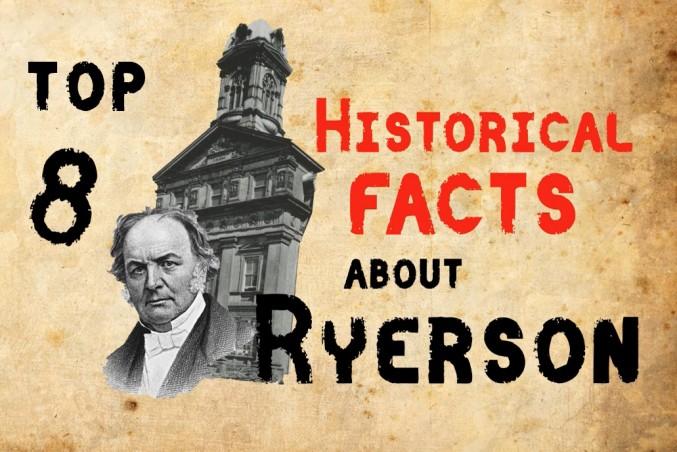By Behdad Mahichi and Natalia Balcerzak
[youtube]https://www.youtube.com/watch?v=zoS5ztKRIow[/youtube]
Many are unaware that a walk through campus is also a stroll through history.
In the summer of 1850, Egerton Ryerson purchased six acres of swampy ground on behalf of the government of Upper Canada. Toronto was still a small town, with muddy streets and undeveloped land — there was a lot to do before it became the biggest city in Canada.
Before Ryerson University stood upon its grounds, there was the Normal School that was built in 1852. It was the first institution in Ontario that trained elementary school teachers. It also served as an art gallery and museum, with its surrounding area used for agricultural experimentation.
St. James Square became known as the property that the Normal School was placed on.
The Eyeopener scurried through dozens of archived documents to bring you our top eight picks of Ryerson’s history.
1. Eggy the Ram wasn’t always a plush mascot:
Live rams were kept on campus till 1991, serving as the school’s spirit animal. Since the 60’s, Ryerson owned a succession of six live rams that would make appearances at events like the Parade & Picnic, convocation and hockey games.
The Humane Society pressured Ryerson to switch to plush after it was revealed that Eggy was tranquilized every time he made an appearance. In times when the drug would wear off, he would charge towards the crowd.
The ram was also a popular target for kidnapping. In November 1980, Eggy spent a weekend alone in a fashion department bathroom as part of a suspected practical joke.
Once they died, their preserved heads were hung at the Ram in the Rye. Ryerson’s archives finally claimed them after the cigarette smoke began to decay the rams.
2. Pitman Hall’s original design had balconies:
As the university’s largest residence, it’s home to more than 550 students. Built in 1991, its original draft proposal included balconies on most floor. The idea was later scrapped after safety precautions were taken into consideration.
3. Canada’s first ever live broadcast:
Ryerson students presented the first live television show produced in Canada in 1949. They performed “This is The Fashion” for 300 members of the radio industry. They all assembled to see the “new type FM receiver” on screen.
More than $60,000 worth of equipment was used for the broadcast.
The Little Daily, a publication from the School of Graphic Arts, reported on the event and tried to explain to its readers — with great detail — what a television was.
4. A winning football team in the 50’s:
This year marks the 50th anniversary since Ryerson’s football team made its last campus appearance.
At one point, the team was coached by former Toronto Argonauts and Grey Cup champion Ted Toogood.
His credibility enhanced Ryerson’s athletic program and helped turn the Rams into a winning team. In 1958, they won the Intermedia Intercollegiate Ontario-Quebec Conference championship.
By 1964, the team was axed due to costs, lack of proper facilities and poor attendance. Ryerson has yet to acquire enough resources to bring back the team.
5. Royal Canadian Air Force training grounds:
During World War II, students were temporarily relocated as the grounds were used to train pilots how to drop bombs. St. James Square also became the training headquarters, provincial then federal.
A cool feature of the training included the “cloud room,” which was used as a stimulater that re-enacted war scenarios for pilots. They were taught how to coordinate a plane in stressful situations.
6. Ryerson’s ban on smoking inside:
Faculty and students were banned from smoking inside classrooms in 1976, but were still allowed in the hallways and cafeteria until 1988.
When the ban was issued, there was a huge campus outcry. Many students refused to follow the rules and claimed that they weren’t able to focus during their lectures without their cigarettes. Even professors supported their rebuttals and tried to challenge the ban.
7. Ryerson’s Coffee House – “The Pornographic Onion”:
It was referred as one of the best university bar/cafe of the time. The Globe and Mail even called it as “one of the finest night spots in Toronto.” It was a part of the popular emerging Canadian folk music scene.
Previously located in the MGM building at the corner of Victoria and Gould streets, it was closed down with the building in 1970. Students tried to re-open the coffee house in Jorgenson Hall but it never lived up to its previous glory.
8. Ryerson demolishes the Toronto Normal School:
As the Ryerson Institute of Technology, established in 1948, began to expand and outgrow the ageing St. James Square buildings — it was an indication to let go of the past and build a modern campus.
Between 1958 and 1963, all the structures were demolished and replaced by the Kerr Hall quadrangle. Only the front facade of the Normal School was preserved and is now the arched entrance leading to the university’s underground recreation and athletics centre.










Leave a Reply